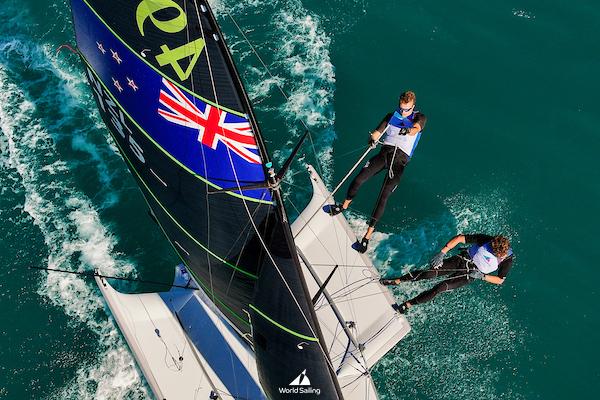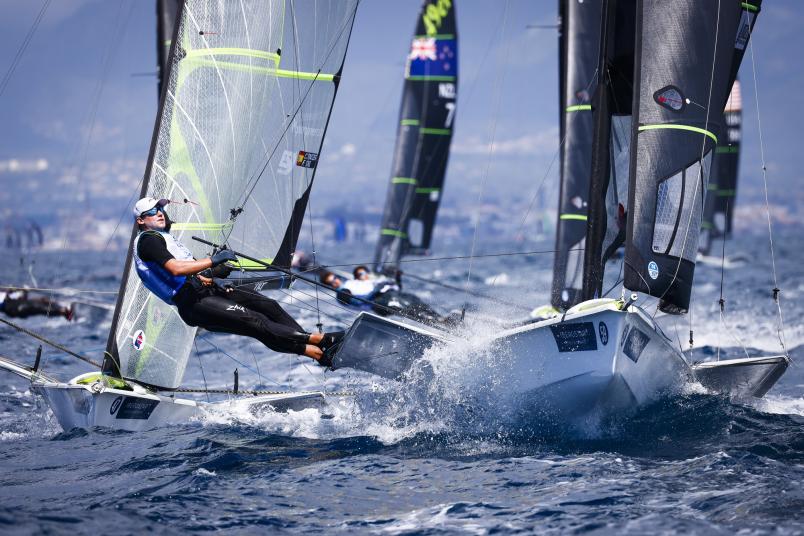The Olympic success of Isaac McHardie and Will McKenzie will further inspire a talented group of young 49er sailors, setting the stage for an exciting year for the next generation of Kiwi skiff talent.
That’s according to Markus Sommerville, Yachting New Zealand’s development coach.
And says Somerville, judging by performances in 2024, there is much to look forward to next season.
Francesco Kayrouz and Hamish McLaren stole the spotlight in July when they won the silver medal at the junior world championships in Spain.
Fellow Kiwis Seb Menzies and George Lee Rush finished fourth, after leading in the early stages of the regatta. Menzies and Rush also narrowly missed out on the gold fleet at the 2024 European championships at La Grande Motte International Regatta, where rising crew Campbell Stanton and Will Shapland finished an impressive 25th.
Mattias Coutts and Henry Haslett had an excellent Princess Sofia Regatta this year, making the gold fleet, while new pairing Sam Bacon and Blake McGlashan are also set to make their debut on the international stage in the coming season.
Somerville said McHardie and McKenzie’s silver medals at the Paris Olympics have added extra motivation for the squad.
“The guys definitely draw inspiration from these previous successes, especially having worked closely with them,” he said.
“Will and Campbell were lucky enough to be Isaac and Will’s training partners in Marseille before the Games, and you could sense their determination to achieve something similar in the next cycle."
Asked what has contributed to the country’s success in the 49er class – New Zealand has now secured a podium finish in the class at the last four Games – Sommerville said it is an exciting class and sailors are naturally attracted to it with the direction the sport is taking.
“We also have excellent role models who’ve excelled in the skiff classes, both men and women. The 29er is a fantastic feeder class where we have excellent coaching and IP that helps sailors step into the 49er and FX,” he said.
“Drawing on the knowledge we have in New Zealand and the quality of domestic racing and training have been critical to fast-tracking their sailing.”
While the squad spends extensive time on the water, the off-water work has been crucial in establishing both quality and depth.
“It’s been a steep learning curve since we started with the development squad shortly after the Tokyo Games,” Sommerville explained. “Initially, we
focused on fundamentals — balancing sailing with university or work commitments and teaching them how to properly manage a campaign. When
you’re 18, you often don’t know how to book accommodation abroad, let alone ensure it has a washer and dryer!
"Our campaign blueprint focuses on how planning enhances performance, and we break down every aspect of a campaign for analysis.”
Yachting New Zealand has also been focused on building a shared identity within its performance squads over the last year, outlining goals and values that will guide them.
“On the water, the boys are fiercely competitive, but once ashore, they’re mates who can have a laugh together.”
The five teams will have their first opportunity to prove themselves at World Cup events in Palma de Mallorca and Hyères early next year.
Somerville believes top 25 and even top 10 finishes are within reach.
“There is a lot of hard work to put in to set them up to be competitive at the world champs in Cagliari, Italy next October,” he said. “I’m excited about the year ahead."
Meet the fleet
The comeback kings: Francesco Kayrouz and Hamish McLaren

"Fran and Hamish are bounced back incredibly to win silver at the junior worlds despite Fran breaking his foot only a few months before the event,” Somerville said. “Fran has had plenty of success in the youth classes, having won the youth worlds in the 29er, and Hamish is an exceptional catamaran sailor. Together, they’re unflappable - they take everything in their stride. They’re keen to improve their light-air sailing this year. It’s an
area where Isaac and Will excel and hopefully, we can learn some tricks from them.”
The heavyweight: Seb Menzies and George Lee Rush

“A lot is expected of Seb and George. Interestingly, when they sailed together in the youth classes, their roles were reversed - George was the helm and Seb was the crew. This versatility gives them an edge, as they essentially have two helms on board. They’re also great friends, which helps their dynamic. Despite still being a bit light for the boat, they sail like heavyweights.”
The speedsters: Campbell Stanton and Will Shapland

“Will and Campbell complement each other perfectly. Campbell is excitable, while I call Will ‘The Iceman’ because he’s always so calm. They’re both highly intelligent and fast in a range of conditions. When they’re on, they’re one of the fastest teams in the world. Their biggest challenge this year will be figuring out how to bring it all together on the racecourse.”
The newbies I: Sam Bacon and Blake McGlashan
“Although they’re a new pairing, Sam and Blake clicked almost immediately. Their boat handling is exceptional and they’ve been pulling off manoeuvres in strong winds that I don’t think many Olympians could manage. They haven’t yet competed internationally as a team, but I’m excited to see what they do.”
The newbies II: Mattias Coutts and Henry Haslett
“Mattias and Henry haven’t had a lot of time in the class together but got an amazing result in Palma. This year could be a really big one for them.”




